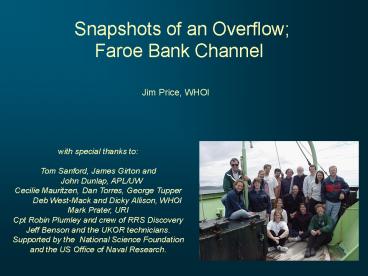Snapshots of an Overflow Faroe Bank Channel - PowerPoint PPT Presentation
1 / 60
Title: Snapshots of an Overflow Faroe Bank Channel
1
Snapshots of an Overflow Faroe Bank Channel
Jim Price, WHOI
with special thanks to
Tom Sanford, James Girton and John Dunlap,
APL/UW Cecilie Mauritzen, Dan Torres, George
Tupper Deb West-Mack and Dicky Allison,
WHOI Mark Prater, URI Cpt Robin Plumley and crew
of RRS Discovery Jeff Benson and the UKOR
technicians. Supported by the National Science
Foundation and the US Office of Naval Research.
2
(No Transcript)
3
(No Transcript)
4
(No Transcript)
5
Goals and Methods
To infer dynamics of exchange and mixing 1)
Transport of volume, T, S and other
properties, 2) Potential vorticity and Bernoulli
function of the current, 3) Variation of
properties along the path of the overflow, 4)
Bottom stress and boundary layer structure. By
observing hydrography and velocity on sections
that span the overflow 1) Hydrography by CTD at
about 210 stations, 2) Currents by Lowered
Acoustic Doppler Profiler calibrated with ships
DGPS and ADCP on all CTD stations, 3) Currents by
eXpendable Current Profilers on about 100
stations, 4) Water sampling for nutrients on
about 100 stations.
6
section name, repeats
I
H,2
E
D,4
G,2
F,2
C
A,2
Latitude
B,2
17 sections in total
Longitude
7
N Atlantic inflow
FBC overflow
Northeast Atlantic W
Arctic Int. W
Norwegian Sea Deep W
8
XCP at CTD 6
9
(No Transcript)
10
(No Transcript)
11
(No Transcript)
12
overflow regimes
descent from the sill
Latitude
approach to the sill
Longitude
13
(No Transcript)
14
(No Transcript)
15
(No Transcript)
16
(No Transcript)
17
(No Transcript)
18
(No Transcript)
19
(No Transcript)
20
(No Transcript)
21
(No Transcript)
22
(No Transcript)
23
(No Transcript)
24
total transport
source transport
25
(No Transcript)
26
(No Transcript)
27
ctd D2
this view is from the SE
this view is from the NW
28
(No Transcript)
29
(No Transcript)
30
Reykjanes Ridge
31
(No Transcript)
32
how much mixing/entrainment? B L1/L2,
0 lt B lt 1, M M0/(1 B)
33
B(source transport, downstream location)
34
(No Transcript)
35
(No Transcript)
36
(No Transcript)
37
(No Transcript)
38
Cd 0.0018
Cd 0.0020
39
(No Transcript)
40
(No Transcript)
41
(No Transcript)
42
FBC Overflow approach to the sill
Overflow currents and relative vorticity are
comparatively small in the Faroe-Shetland Trough.
Variability due to tides and mesoscale features
is comparable to that of the overflow current and
mass field in this region. Transport of source
water is about 1.8 Sv on average over 15
sections. Transport varies in time due mainly to
changes in the thickness of the overflow. Some
aspects of the overflow structure remain nearly
constant. There is evidence of somewhat elevated
vertical mixing within the overflow in the
Faroe-Shetland Trough and some spatially
localized horizontal mixing (or exchange) across
the Wyville-Thomson Ridge. There is no evidence
of significant entrainment in this region. The
dynamics appears to be mainly inviscid in that
1) Bottom stress is not large, generally, 2)
Acceleration of the current is consistent with a
nominal along-stream pressure gradient (w/
caveats), 3) The horizontal structure of the
overflow current is consistent with PV
conservation and partial blocking of the deepest,
densest part of the Norwegian Sea Deep Water.
43
FBC Overflow descent from the sill
The topography opens up dramatically beyond the
FBC narrows, and the overflow spreads as
width/distance O(1). It descends rather
gradually. There is no obvious instability/eddy
generation process as occurs in Denmark
St. Bottom stress is significant, up to 3 Pa,
but there is only modest veering in the bottom
Ekman layer. Spreading is mostly barotropic.
The bottom and interfacial boundary layers
begin to merge and mixing/dissipation is of
considerable importance in the Bernoulli and PV
balances. There is clear evidence of significant
entrainment, E We/U 3x10-4 , based upon the
spatial rate of change of transport-weighted T or
S. Density is changed somewhat less than T and
S. The large Froude numbers are approx 1,
though smaller values can be found. The inferred
entrainment rate and Fr are not inconsistent with
the trend of E(Fr) observed in other density
currents.
44
(No Transcript)
45
(No Transcript)
46
(No Transcript)
47
(No Transcript)
48
(No Transcript)
49
(No Transcript)
50
(No Transcript)
51
(No Transcript)
52
(No Transcript)
53
(No Transcript)
54
(No Transcript)
55
(No Transcript)
56
(No Transcript)
57
(No Transcript)
58
(No Transcript)
59
(No Transcript)
60
(No Transcript)



















![How to Fix Overflow Error in QuickBooks Desktop [Complete Guide] PowerPoint PPT Presentation](https://s3.amazonaws.com/images.powershow.com/9206477.th0.jpg?_=201901140411)











